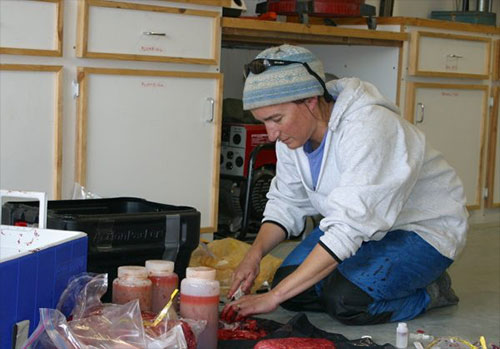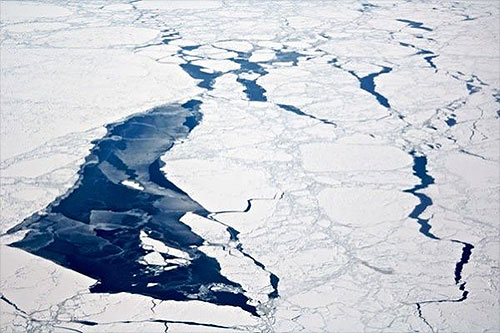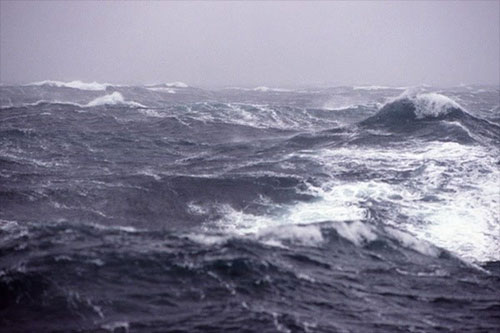
Bering Sea transforms: ‘We have never been here before’By PAULA DOBBYN
December 31, 2018
“We have never been here before,” said Alaska Sea Grant Marine Advisory agent Gay Sheffield. Sheffield, who is based in Nome on the Bering Sea’s eastern shore, has seen the change firsthand as she works with communities, tribes, federal and state agencies, and the general public . “Two marine ecosystems are rapidly merging,” she said. “What happens next is unknown and will potentially affect us all.”
Since record-keeping began in 1850, sea ice had never been as scarce as it was during the winter months of 2017–2018, according to scientists. John Walsh of the International Arctic Research Center at the University of Alaska Fairbanks attributes it to three things: above average air temperatures during the fall, a very stormy winter and warm water temperatures. As the ice melted, the thermal barrier separating the northern and southern Bering Sea disappeared, allowing two marine ecosystems to converge. As a result, fish, birds, marine mammals and other marine wildlife have been changing patterns. The National Oceanic and Atmospheric Administration’s Alaska Fisheries Science Center recently released preliminary data from trawl surveys done during 2010, 2017 and again this summer in the northern Bering Sea. The latest survey indicates that the biomass of walleye pollock increased over 5,000 percent compared to 2010 while Pacific cod increased more than 2,000 percent.
The multiyear gap between surveys has raised many questions about whether the cod and pollock increase came from the southern half of the U.S. Bering Sea or the Russian side of the Bering Sea. Or perhaps the fish have matured in the northern Bering Sea since the last survey. Scientists are not sure. At the same time, some species of forage fish have declined significantly. For example, the biomass of smelts and Arctic cod, important fish to northern Bering Sea marine wildlife, has dropped by 98–100 percent between 2010 and 2017. Meanwhile, U.S. Fish and Wildlife Service and the National Park Service began receiving reports last May of dead and dying seabirds from communities along the northern Bering and southern Chukchi seas. Investigators at the U.S. Geological Survey’s National Wildlife Health Center examined carcasses and concluded that the birds died of starvation. The die-off involves murres, shearwaters, puffins, fulmars, kittiwakes and auklets. It’s continuing and now includes the Pribilof Islands and northern Gulf of Alaska, according to the U.S. Fish and Wildlife Service. The Fish and Wildlife Service is receiving information from Alaska Sea Grant, Kawerak Inc., Aleut Community of St. Paul Island, Alaska Migratory Bird Co-management Council, National Park Service, and the Coastal Observation and Seabird Survey Team.
The approximately 1,500 seabirds reported by communities is likely only a small fraction of the overall number seabirds affected. An indicator of ocean ecosystem health, seabirds are often likened to the proverbial canary in a coal mine. Marine mammals also struggled this summer. For example, 48 dead seals were documented in a half-mile stretch of beach near Wales. There were many other marine mammal stranding events as well. All signs point to a quickly changing environment in the northern Bering Sea, and this creates challenges and concerns for the residents of northern coastal communities who depend upon the sea’s bounty for their nutritional, cultural and economic needs.
Questions and Answers with Gay Sheffield Alaska Sea Grant is part of the UAF College of Fisheries and Ocean Sciences and NOAA’s National Sea Grant Program. Sheffield, Alaska Sea Grant’s Nome-based Marine Advisory agent, offered more insights into recent events in response to the following questions: Question: Gay, what are some of the things that you have noticed recently as far as changes in the environment in your region? Gay Sheffield: Lack of sea ice and the increased duration of open ocean in such a biologically rich and strategic location as the Bering Strait region is driving the environmental and industrial changes we are seeing in our ocean waters. In the last 10 years, the regional communities have had to respond to:
We are also witnessing industrial changes. There has been an increase in the volume, duration and type of industrial ship traffic. This includes commercial fishing, gold dredging operations, oil exploration, research vessels, cruise ships and military vessels using the Bering Strait region and the Port of Nome. Q: What are the impacts to the people who rely on Bering Sea resources? GS: Communities in the Bering Strait are rich in culture yet are often economically challenged. The subsistence harvest of marine resources remains essential to the nutritional, cultural and economic needs of our coastal communities. Impacts include food security, public health, increased risks to subsistence mariners, loss of income, as well as increased uncertainty and stress. Q: How are you working with stakeholders and agencies? GS: In multiple ways. A partial list includes:
Q: What could be done better? GS: It is difficult to have a meaningful dialogue with the diverse northern Bering stakeholders or with your authorized agency employee when you have little understanding of each other’s knowledge, resources and challenges. Currently, those agencies are almost exclusively located far from the Bering Strait. For example, Anchorage is 500 miles, Juneau is more than 1,000 miles, and Seattle is some 2,000 miles away. While these agencies may not be able to base staff in Nome or Bethel or Kotzebue, we must work to improve two-way communication and understanding. Additionally, in the Bering Strait region we share the waters and all our marine resources with Russia. Transboundary communications with our neighboring coastal communities to the West is highly desirable. Right now, communications between U.S. and Russian federal marine wildlife and fisheries managers is extremely limited. We are in uncharted territory, and we need to come together to address the immediate concerns that face us. Q: What are some of the most important things for the public to know about the Bering Sea? GS: A cascade of physical and biological events is ongoing at the ecosystem level. “Unprecedented” is the word that is being used to describe lack of sea ice, warm ocean temperatures, weather patterns, and the increases or decreases in our marine commercial and subsistence resources. In other words, we have not been here before. Two marine ecosystems are rapidly merging. What happens next is unknown and will potentially affect us all. Q: Why should people outside of the Bering Strait region care about what is happening in the northern Bering Sea? GS: One way or another, we all rely on the Bering Sea for food. Changes in its ecosystems have the potential to affect us all. The southern Bering Sea is home to some of the largest commercial fisheries in the world. In the U.S., the southern Bering Sea provides a large percentage of the domestically harvested fish we eat. The western Bering Sea, together with the Sea of Okhotsk, substantially feeds Russia and contributes to the global seafood market. Meanwhile, the northern Bering Sea is home to some of the largest populations of Arctic marine wildlife, including walruses, bowhead whales and bearded seals, that remain essential to remote subsistence coastal communities and to the overall health of the Arctic. There is significant change unfolding and how it plays out will affect everyone, directly or indirectly. Q: How can people help? GS: Regionally, people should report the unusual, whether it’s dead, sick marine wildlife or whether it’s something you’ve never seen before. Take a photo if possible and call me at 907-434-1149 or the director of the Kawerak Subsistence Program, Brandon Ahmasuk at 907-443-4265. We will do our best to help get information to the correct responders and help them get their results back to communities. Please spread the word that things are changing rapidly in the Bering Sea and this directly and profoundly affects many people.
|
|||||||


